Black Sea "land mines"
Soviet "pahari of the sea"
Mine weapons proved to be effective during the Russo-Japanese War. Then he was actively used by the opposing sides during the First World War. During the Civil War, reds, whites, and invaders laid thousands of mines on the seas and rivers of the former Russian Empire. After the end of the conflict, for many years the mine threat persisted, with which obsolete minesweepers actively fought. In 20-30-ies. Twentieth century. mine weapons developed at an accelerated pace, while the means of fighting them were also improved. Shagal with the times and the young Soviet state. In the years of the first Soviet five-year plans, the minesweepers of the 3 project’s BSShch project (according to the classification of that time, high-speed or basic) were included in the programs of military shipbuilding. In 1933-1934 in Sevastopol were laid four first corps. They became part of the Black Sea Fleet in 1936-1937. By this time, there were six more minesweeper hulls on the stocks, which were built according to the revised 53 project. They entered service in 1938 g, but two of them were sent to the Pacific by order from Moscow. In 1937-1939 laid seven more minesweepers, they were built on a modernized project 58. In 1939-1941 five "plowmen of the sea" replenished the Black Sea Fleet, and two ships were again sent by the command to strengthen the Pacific Fleet. Two more hull minesweepers such as "land mines" remained unfinished. Thus, the composition of the Black Sea Fleet included 13 BTSCH. They comprised two BTsch divisions that became part of the main battlefield base unit of the Black Sea Fleet, created by 24 in August 1939. High-speed minesweepers were based in the South Bay of Sevastopol, their crews were actively engaged in combat training and participated in all naval exercises and maneuvers.
The outbreak of war
On June 22, German planes dropped mines on the Sevastopol fairway. On this day, the T-401 Tral was sent to patrol. From the first days of the war, the Nazis actively used mine weapons in the Black Sea. They put magnetic mines on the fairways of the Black Sea Fleet bases. The Black Sea Fleet command, following the directives from Moscow, issued an order to set up defensive minefields. Landmines also took part in these works - in June and July 1941 minesweepers laid mines at Odessa, Novorossiysk, Anapa, in the Kerch Strait, in the Kiliysky estuary of the Danube and at Oyster Lake. In addition, they were actively used to cover mine productions of cruisers, destroyers and minzags, trawled mines and carried patrols near Sevastopol. Soon the German intensified its actions aviation, and BTSC began to actively engage in the escort of transports to Odessa, the ports of Crimea and the Caucasus. As one of the OVR seamen noted: “High-speed minesweepers, due to the lack of escort ships, freed them from their direct duty - the fight against mines! Paradox - escort patrol boats destroy mines, and minesweepers stand at the pier or escort convoys. ” At the same time, losses were avoided, but this could not continue forever. September 12, during the formation of a new convoy near Feodosiya, a T-402 Minrep was blown up by a mine. Within a few minutes he sank, 61 sailors died.
German troops seized the whole of Ukraine and tried to break through to the Crimea, they planned to seize Sevastopol. On September 26, the command of the Black Sea Fleet sent a T-403 "Cargo" to the Perekop isthmus to bombard German troops. In the evacuation of Odessa, the minesweepers T-404 “Shield”, T-405 “Fuse”, T-406 “Iskatel” and T-407 “Mina” took part. High-speed minesweepers put mines in the port and on the approaches to it - 14 of October T-405 “Fuse” put 30 mines at Grigorievka, 16 of October, he 50 mines mined the port of Odessa, 20 of October its sailors put 26 mines in the Odessa Bay. October 24 T-404 Shield and T-408 Yakor put 27 and 26 mines in the Dnepro-Bug estuary. The Black Sea Fleet lost part of its bases and moved to the Caucasus, parts of the Wehrmacht broke into the Crimea. The coastal battery No. 54 was the first to defend the city. For several days the gunners fired at the enemy troops. On November 2, T-406 "The Finder" and two "sea hunters" were sent for them. The 250-day defense of Sevastopol began, which became in our stories symbol of courage and perseverance of the Black Sea sailors.
Defending native Sevastopol
The defenders of the Main Base of the Black Sea Fleet managed to repel the German attacks on Sevastopol and parts of the Wehrmacht, capturing the Crimea, began to prepare for the storming of the fortress. The forces and the Soviet troops were accumulating - they delivered reinforcements, weapons and ammunition by sea, wounded and civilians, various cargoes were taken to the mainland. German aviation received airfields in the Crimea and began systematically bombing the port, enemy artillery constantly bombarded the city and bays, the Germans laid new mines on the outskirts of the port. The main forces of the Black Sea Fleet left for the Caucasus, but OVR ships continued to carry out their difficult service: they fought with mines, went on patrol, covered convoys, transported reinforcements and cargo, escorted transports and fired at enemy positions from Sevastopol and Balaklava. In Sevastopol remained T-413, ten "sea hunters", nine boats of the type KM, seventeen KATSCH and floating battery number XXUMX. The base minesweeper carried patrols of approaches to the fortress, he met convoys and warships, with a pilot and navigator of the division on board. Trawlers repeatedly came under attacks of the enemy, they were constantly attacked by German aces. Not always the ships managed to avoid damage, the crews suffered losses. Damaged BTSHCH became in repair and the load increased on the remaining "plowmen of the sea". In December, the German units launched an assault on Sevastopol. From 3 to 1 in December, the minesweepers fired 29 at the enemy’s advancing forces and spent 29 659-mm shells. In December, the T-100 Tral, T-1941 Shield, T-401 Explosion, T-404 Defender and T-410 took part in the Kerch-Feodosiya landing operation, which facilitated the position of defenders fortress and allowed the Soviet troops to create a springboard for the offensive in the Crimea.
A more difficult task was posed by the Black Sea Fleet command to the commander of the T-405 "Fuse". January 4, 1942 he left Sevastopol with paratroopers on board. He, along with the tug SP-12, the seven "sea hunters" on the night of January 5 landed 740 paratroopers and three in Yevpatoria tank. They managed to quickly capture the city center, but they could not develop success. The Germans quickly tightened their reserves, and the Soviet troops did not receive help due to bad weather. At dawn, aviation entered the business, and the minesweeper, who helped the paratroopers with fire from guns, received significant damage. On the evening of January 5, the waves threw the damaged ship onto the sandy shore 6 km south of Yevpatoriya. On the morning of January 6, the “Fuse” was shot by German tanks, and the remaining troops were destroyed or captured, only a few were able to break through to the partisans.
After intense landing operations, the pahari of the sea returned to their “direct” duties - escorting transports and convoys, delivering cargo, ammunition and supplies to Sevastopol. During the spring of 1942, the Germans intensified the blockade of approaches to the fortress, they attracted torpedo bombers, torpedo boats and mini submarines to actions on Soviet communications, the number of raids on the port increased significantly. The blockade of the fortress began, and all ships with cargoes for the defenders had to break into the fortress with a battle.
On May 27, Georgia was successfully broken through to Sevastopol. He was accompanied by the destroyer "Impeccable", T-404 "Shield", T-408 "Anchor" and T-409 "Harpoon". In the evening of June 2, the tanker Gromov was sunk near Yalta. He was accompanied by T-411 Defender, T-412 and 4 patrol boats, but they could not repel the attack of 10 torpedo bombers. June 7 Wehrmacht units launched a new assault. 10 June T-408 "Anchor" and T-411 "Defender" supported by the fire of the Red Army, 11 June T-401 "Tral" and T-410 "Explosion" fired at the German troops. Soon, the defenders of the fortress began to be in dire need of ammunition and replenishment. It was necessary to urgently deliver cargo to Sevastopol and evacuate the wounded. On June 10, the Abkhazia transport escaped to the port, accompanied by the Svobodny destroyer, the T-408 Yakor minesweepers and the T-411 Zashchitnik. 11 June blockade broke through the transport "Bialystok". He was accompanied by the T-401 "Thrall" and the T-410 "Explosion", which were immediately sent by the SoR command to fire on the advancing German units. 12 June came the transport "Georgia", which was accompanied by T-404 "Shield" and T-409 "Harpoon". June 13 T-413 was sunk by German aircraft on the outer roadstead of Sevastopol, 18 seamen died. During the raids on Sevastopol 17 and 18, the T-409 “Harpoon” was heavily damaged in June, but it was removed for repair in Tuapse. To restore it, parts of the hull of the unfinished minesweeper were used. In the evening of June 19 at Cape Fiolent, the enemy's torpedo bombers sank the Bialystok transport. He was accompanied by the T-408 "Anchor" and 5 patrol boats. German aircraft continued raids on the remnants of the convoy. Minesweeper received significant damage from close bomb explosions, but 20 managed to get to Tuapse in June. At least 150 tons of water entered the minesweeper compartments, the sediment increased by 0,5 m, the list on the port side reached 12 degrees.
Meanwhile, the agony of Sevastopol began, and the minesweepers took part in the evacuation of the wounded and defenders of the fortress. But it was not organized and took place in the most difficult conditions - the complete domination of German aircraft in the air, a large number of enemy boats on the sea approaches to the city, a huge number of people abandoned by the command of SOR to fend for themselves, around 35 batteries without ammunition, food and water. 2 July, the minesweeper T-410 "Explosion", T-411 "Defender" and "sea hunters" engaged in evacuating people from Sevastopol. They took on board up to 700 people and managed to break through to Novorossiysk. T-404 “Shield”, which was going to an agonizing fortress, was attacked by German aircraft. As a result, damaged by close breaks, he could not break through to Sevastopol. He returned to Novorossiysk, removing a man from the GTS seaplane along the way 32. Soon the fortress fell, and most of the defenders of the Black Sea stronghold were captured.
Off the coast of the Caucasus and on enemy communications
The main task of the “plowmen of the sea” was still escorting the convoys along the Caucasus. They accompanied the transports and tankers along the Batumi-Poti-Tuapse-Novorossiysk route, escorted warships, carried out various assignments of the command of the Black Sea Fleet. The minesweepers took part in the production of a defensive minefield at Novorossiysk. 16 July 150 mines were delivered gunboat "Red Abkhazia", T-401 "Tral", T-406 "Iskatel" and T-412. On the night of July 31, the T-407 “Mina” and the T-411 “Defender” shelled Theodosius. On August 14, in the area of Ozereyka, enemy aircraft damaged the T-410 Explosion severely, and with great difficulty the tug Simeiz dragged it to Novorossiysk. September 19 T-401 "Thrall" and T-406 "Finder" fired upon German positions at Myskhako. October 18 T-408 "Anchor" and T-412 fired on Anapa. Almost every transition of convoys along the shores of the Caucasus was accompanied by enemy attacks.
Soon, minesweepers were involved in raid operations on enemy communications. In the first campaign was attended by four minesweepers and the destroyer "savvy". In the morning of December 13, T-406 “The Finder” and T-407 “Mina” attacked the enemy convoy outside the village of Shagany, but during the two-hour battle they could not inflict significant damage to the enemy’s ships. The minesweeper T-406 “Finder” and T-408 “Anchor” did not detect the enemy and fired at its coastal objects. The second march (December 2629) to the shores of Romania also did not bring success to the Soviet sailors, and they limited themselves to firing at objects near the village of Burnas. More to the actions on the communications of the enemy "plowmen of the sea" did not attract. 15 January T-412 received the name "Arseny Raskin" in honor of the deceased 26 in October 1942, the head of the Political Directorate of the Black Sea Fleet, who became famous as a commissioner of the Navy Hanko.
On the night of February 4 1943, three base minesweepers took part in the landing operation in the area of South Ozereyka - Stanichka. T-412 “Arseny Raskin” towed in tow a bolinder №4, Т-411 “Protector” towed a bolinder №6, Т-404 “Shield” dragged bolinder №2. On board the bolinders were tanks. On the territory of the enemy, it was possible to create a bridgehead, called the “Small Land,” which the Black Sea Fleet ships began to provide with replenishment and ammunition. Every night, canlodki, minesweepers, boats, motoboats and seiners brought vital goods for the defenders. For example, during the night of 8 February, the T-404 “Shield” and the T-412 “Arseny Raskin” transported the 144 th battalion of the 83 brigade of marines of 1020 men. They were opposed by the German "mosquito" forces, artillery and enemy aircraft. February 27 at Myskhako torpedo boats of the enemy was sunk T-403 "Cargo", delivering fighters and ammunition. After that, minesweepers were not attracted to the delivery of goods. March 1 minesweeper T-411 "Defender" was awarded the Guards rank.
German submarines began to operate actively along the coast of the Caucasus. March 12 torpedoed the tanker "Moscow", 31 March torpedo hit the tanker "Kremlin". May 22 enemy aircraft attacked a Soviet convoy near Cape Chugovkopas. They sunk SKA No. 041, damaged the Internationale and T-407 Mina. Only the help of aviation saved them from destruction. On June X, near Sukhumi, the German U-15 submarine sank the Defender T-24 Guards, the 411 seafarers died. The security of the convoys was strengthened, Soviet aircraft were actively involved, but the submarines and enemy aircraft did not stop the attacks on the Soviet convoys off the coast of the Caucasus. On November 46, the tanker I. Stalin was torpedoed, on November X the torpedo landed on the tanker Leader, but fortunately it did not explode. 18 January 29, at Cape Anacria, the Germans sank the tanker "Vayan Couturier", which was accompanied by 16 base minesweeper and 1944 "sea hunters".
The end of hostilities on the Black Sea
In the spring - summer of 1944, Soviet troops liberated Sevastopol. The minesweepers continued to escort transports, they were used to transport valuable cargo. In April-May, the minesweepers T-401 “Tral” and T-407 “Mina” received English trawls of the type LL and they began to be called EMTSH. However, the German submarines were still active off the coast of the Caucasus, and the command of the Black Sea Fleet decided to eradicate the threat. 15, 19, 21 and 22 July T-406 "The Finder" set up an anti-submarine minefield (from antenna mines) at Cape Anakriya and Gudauta. Convoys again began to receive additional escort forces, aviation was actively used. 22 July, the base minesweepers T-401 “Tral”, T-404 “Shield”, T-407 “Mina” and T-412 “Arseny Raskin” were awarded orders of the Red Banner for their contribution to the defeat of Germany. Their crews were faced with a tremendous job of trawling German, Romanian, Bulgarian and Soviet minefields. 18 August Red Banner T-404 “Shield” conducted a control trawling of the fairways of the Novorossiysk port. August 20 Red T-407 "Mina" began work on the destruction of magnetic mines in Odessa, in the fall the minesweeper worked on cleaning Constanta and Sevastopol. To clear the mines of the ports of Romania, the command of the Black Sea Fleet sent the 3 minesweeper, the 2 large hunter and small hunter. September 2 The T-410 “Explosion” was sunk on the outskirts of Constance by the German submarine “U-19”, the seaman's 74 died. The boat was pursued, but failed to destroy. This was the last combat loss of the Black Sea Fleet in World War II. The Soviet offensive developed rapidly, and the "pahari of the sea" took an active part in it. September 9 T-406 "Finder" and 4 sentry boats without a fight occupied the Bulgarian port of Burgas, and the red-flag minesweeper T-404 "Shield", a big hunter and 4 "sea hunter" delivered Soviet paratroopers to Varna. Both ports were occupied without a fight, the local population enthusiastically greeted the Soviet troops.
From 15 in October 1944, the red-banner T-407 “Mina” began the trawling of the Sevastopol bays, they destroyed 30 of bottom non-contact mines. From October 28, the Sevastopol fairways began to clean the Iskatel T-406 and the Shield, the red banner T-404, from mines. November 5 Black Sea Fleet ships returned to Sevastopol. This was a great merit of the "plowmen of the sea", whose unnoticed military work is invaluable.
After the war
The fighting on the Black Sea ended, but the mine danger persisted - during the Second World War, 19995 mines and mine defenders were delivered by opponents. Part of the mines were destroyed during the hostilities, but the rest had to be removed as soon as possible. It was a titanic, deadly job and the crews of the base minesweepers coped with it. For example, the base minesweeper T-408 “Anchor” passed 1945 9114 miles, more than 5000 miles with a trawl. The Red Banner T-412 minesweeper “Arseny Raskin” led trawling near Varna, here the 132 mines were destroyed by minesweepers. At Constanta, the Soviet “pahari of the sea” took out a 71 mine. When trawling fairways at the port of Odessa in 1946, 177 mines were destroyed. In 1947, the trawling continued. T-406 “Finder”, the red-banner base minesweepers T-404 “Shield” and T-412 “Arseny Raskin” destroyed the minefield at Evpatoria. In four days, they wiped out the 45 min. In total, for the period from 1945 to 1953, on the Black Sea, 5945 mines and mine defenders were destroyed, and the area in 9624 square miles was protralene. Much of the mines were destroyed by land mines. At the end of 50's veteran ships were withdrawn from the fleet, but for several decades they served in the Black Sea Fleet as experienced ships.
Memory
The memory of the heroic deeds of the crews of the Black Sea “plowmen of the sea” is carefully preserved in the OVR museum in Sevastopol, and in Feodosia there is a small monument in the town cemetery dedicated to the dead sailors of the minesweeper T-402 “Minrep”. A small obelisk was placed in Sevastopol at the Communards Cemetery at the grave of the T-413 minesweeper. In 1947, his body was raised and sent to the "needles". The same fate befell, ultimately, all the Black Sea land mines.
From them, virtually nothing is left except for photographs and memories of sailors who served on these ships. Only in the Central Naval Museum is the controller of the trawl winch from the T-412 “Arseny Raskin” red banner minesweeper stored. Here is the magnificent model of the red T-407 “Mina”, made on the 1: 50 scale in 1951 in the museum’s model workshop.
The feat of the Evpatoria landing was not forgotten either. Vladimir Vysotsky dedicated the song “Black jackets” to this landing. In 1970, a monument was erected at the place of death of the “Fuse”. Its author, sculptor N. I. Bratsun, depicted three sailors, paratroopers, striving in a single impulse to attack. In the Evpatorian city museum there is a hall dedicated to the landing party, and a diorama “The landing of the Evpatorian landing”, created in 1988 by the artist VB Tatuiev.
Tactical and technical characteristics of the high-speed minesweeper T-406 "Seeker"
Displacement standard 400 t, full 494 t, length 62 m, width 7,2 m, draft 2,2 m, two diesel engines 42-БМРН-6 with total power 2800 hp, cruising speed 18,4 knots, cruising range 3300 miles (with 16 knots) ; armament: one 100-mm, one 45-mm, three 37-mm, 2x12,7-mm DShK machine gun, 1x12,7-mm Browning machine gun, 20 depth charges, can take 31 mine of 1926 g. Crew 66 people (7 officers, 59 foremen and sailors).
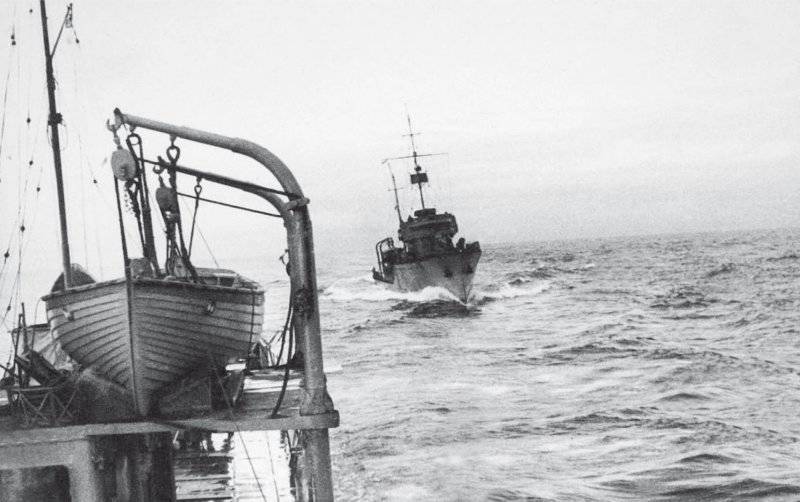
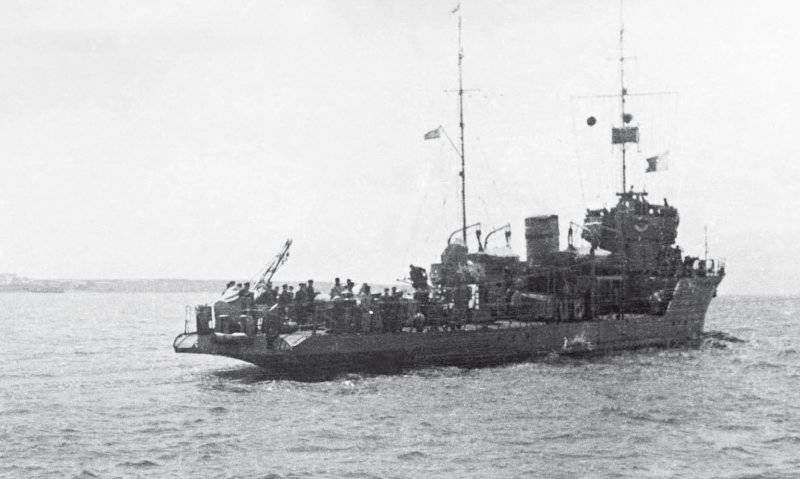
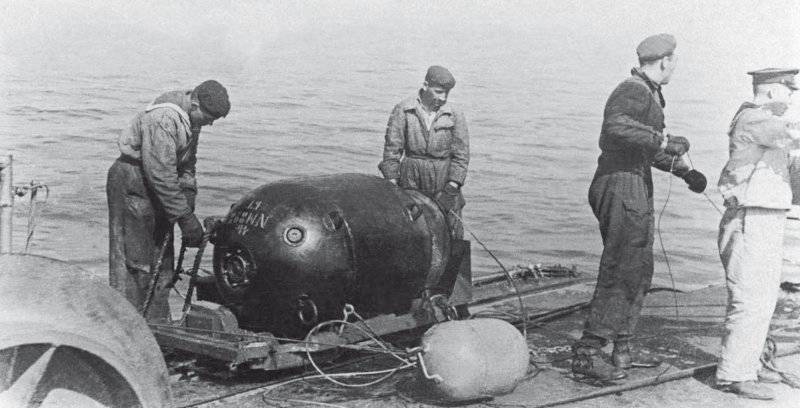
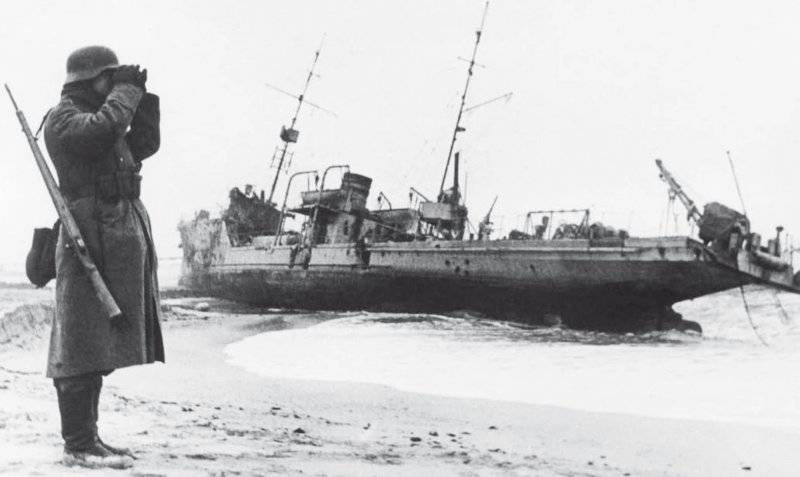
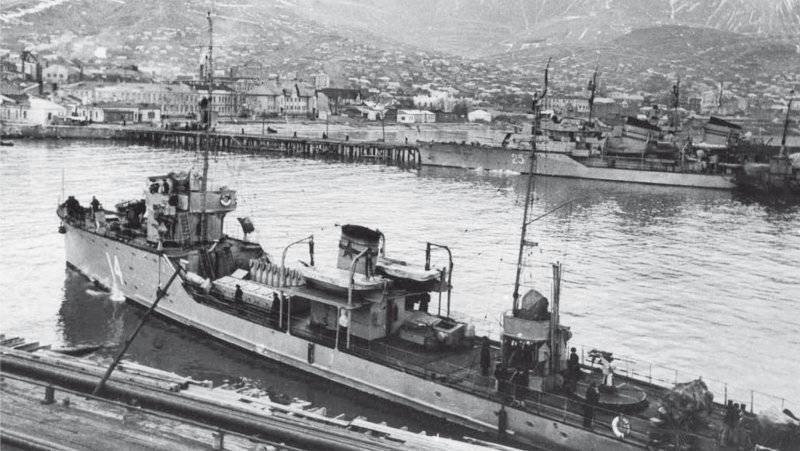
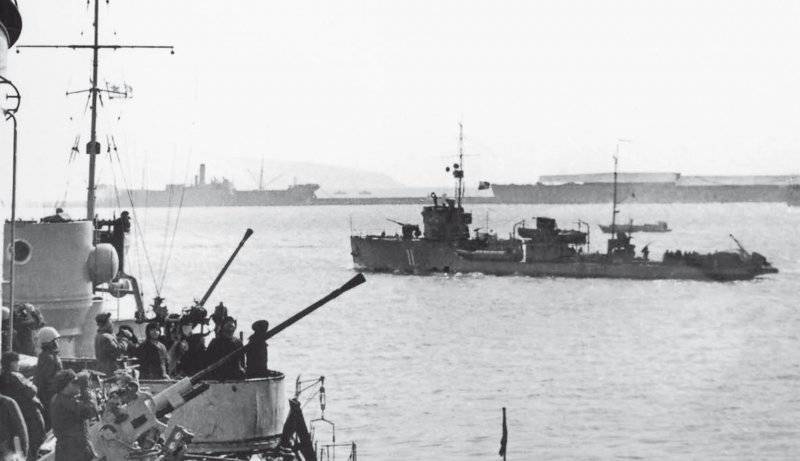
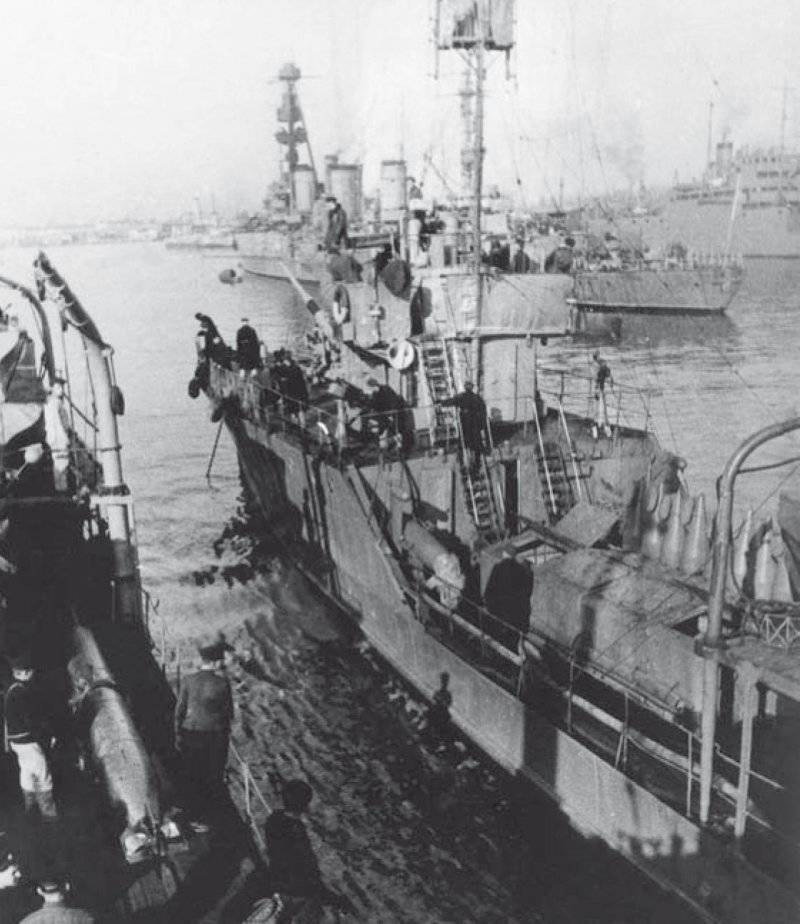
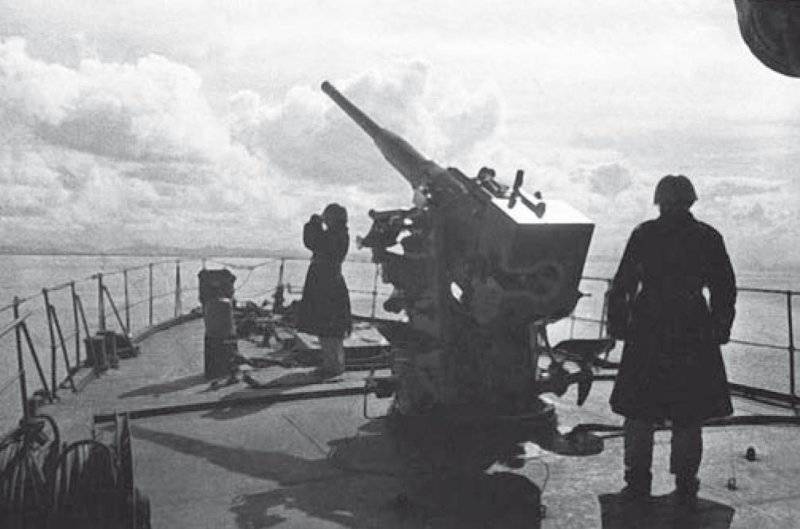
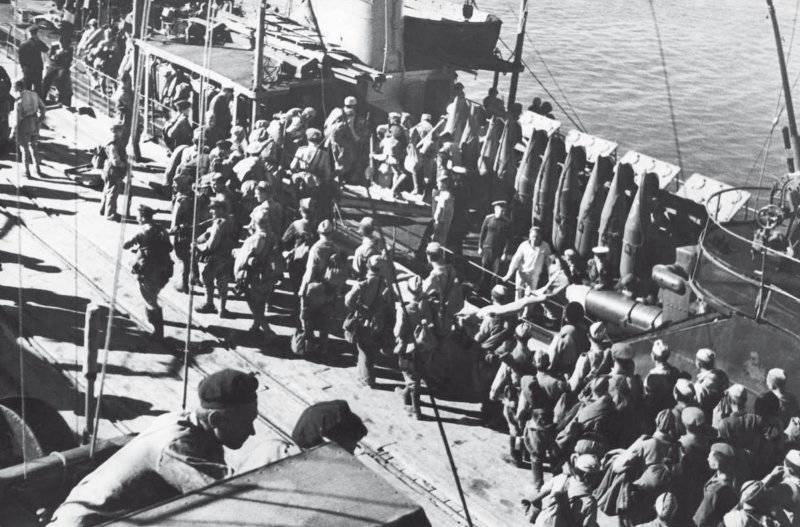
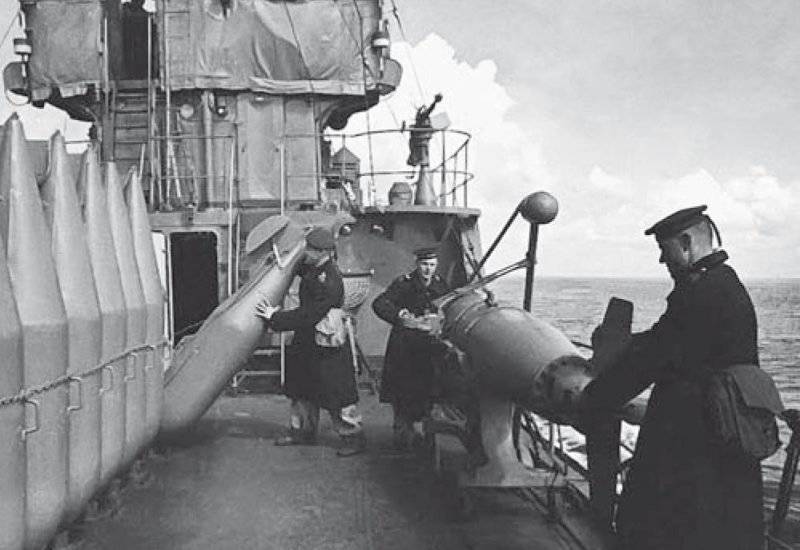
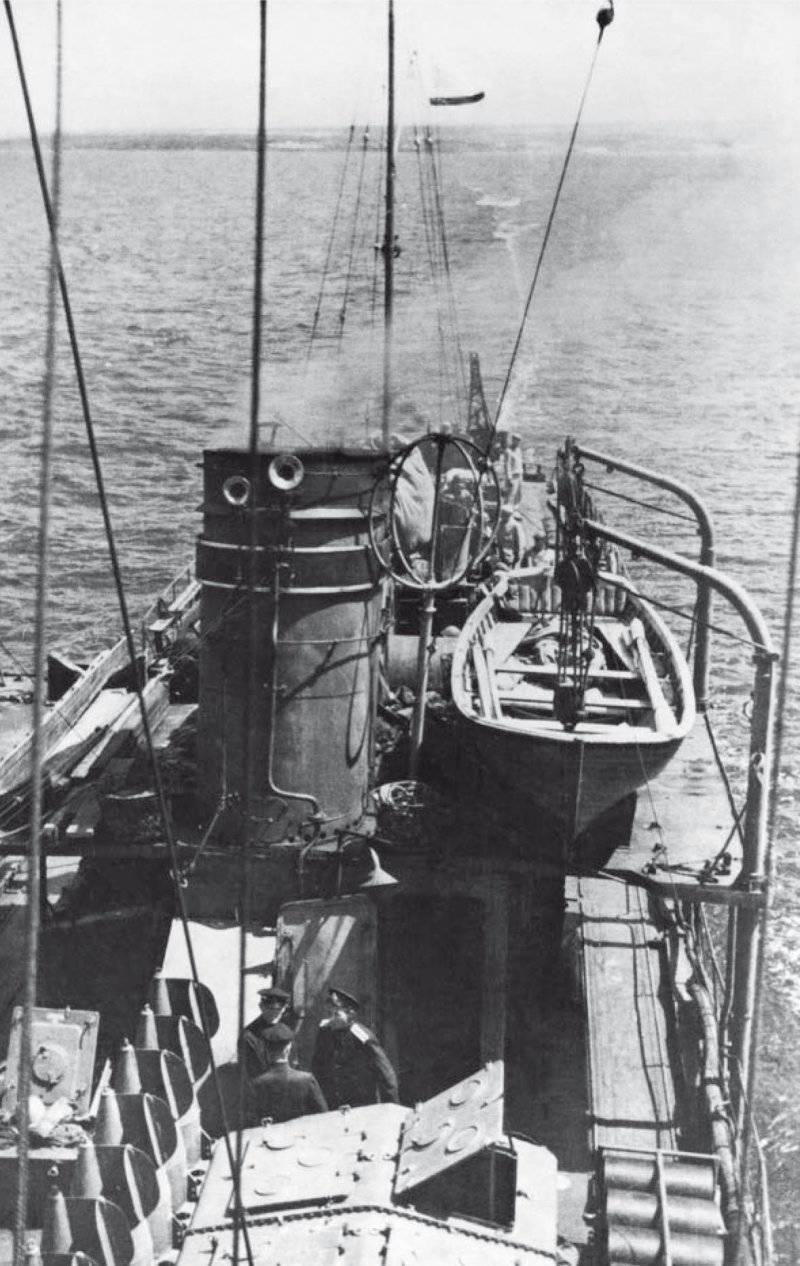
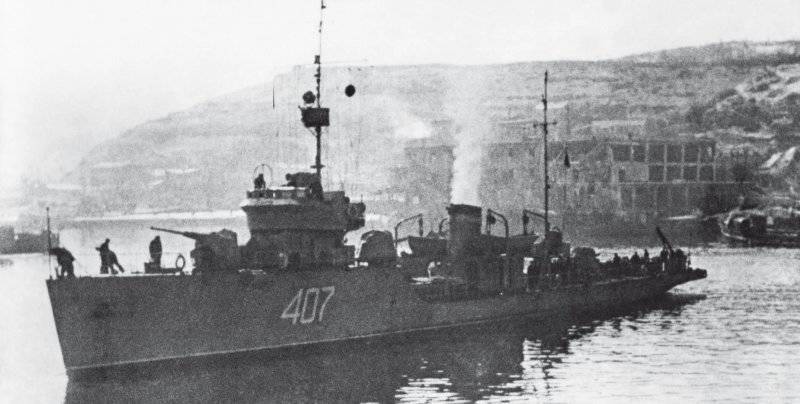
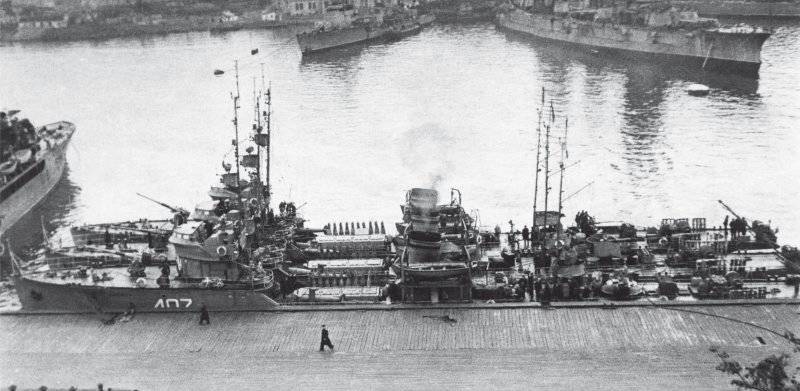
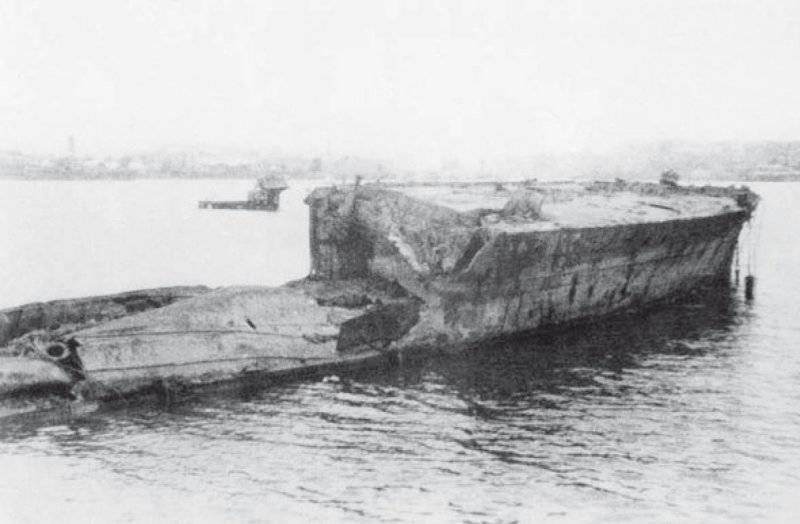
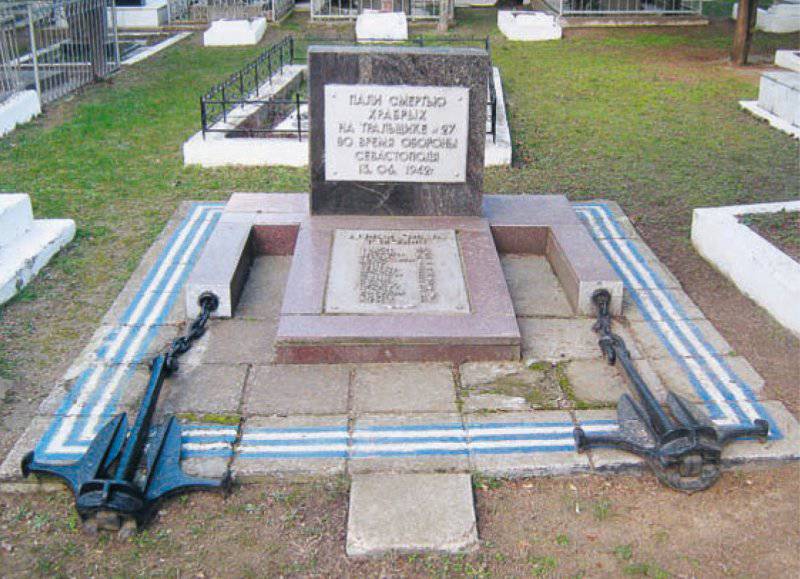
Information